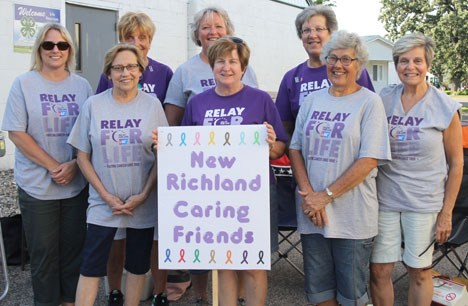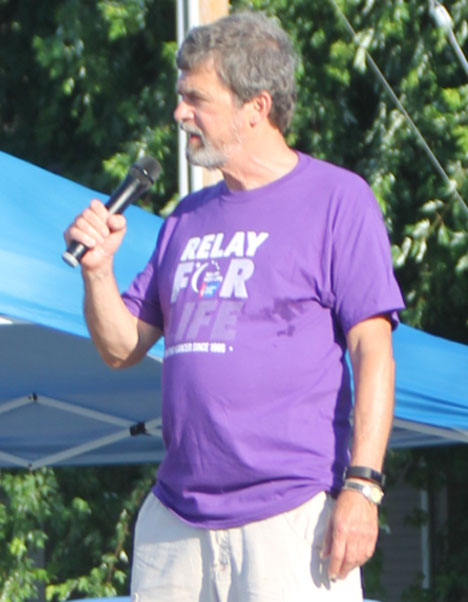Honorary chairman tells of amazing battle with cancer

LOCAL PARTICIPATION — New Richland was again well represented at the Waseca County Relay for Life. The Caring Friends Team, from left: Krystal Maxon, Julie Economy, Georgia Dinneen, Lanae Thorstad, Kris Pfeffer, Bonnie Jacobson, Mary Sack and Gayle Dummer. (Star Eagle photo by Jessica Lutgens)
By JESSICA LUTGENS
Staff Writer
Waseca County Relay for Life returned for the 26th year to the Waseca Fairgrounds on Friday, July 26. The opening ceremony kicked off at 6:30 p.m. with an introduction by masters of ceremonies Molly Penny and Andy Gott, followed by an Invocation by Pastor John Omans from St. John’s Lutheran Church in Waseca.
This year’s honorary chairperson was Bruce Boyce, who served as County Coordinator for Waseca County for 32 years and is currently a paraprofessional with Waseca’s Early Childhood Education program.
“I am very happy to be able to be here to speak with you this evening,” said Boyce to applause from the crowd.
Last summer, Boyce and his wife of 40 years, Sally, were on vacation in Canada when Sally tripped and fell, separating her shoulder. Not long after returning to the U.S. with Sally’s arm in a sling, Bruce started having problems with his health: he had shortness of breath, a resting heart rate way above normal, and he was out of breath after little exertion.
On the night of July 4, 2018, Bruce couldn’t draw a breath, so the next day he went to urgent care. A CT scan and x-rays were performed, and he was told to return the next day. Later that day, Sally was on her way to a doctor appointment in Owatonna when she was T-boned by another vehicle at an intersection not far from her home, totaling her vehicle. She called Bruce, who went to the scene.
About 20 minutes later, Bruce got a call from the clinic. A rapidly growing mass was found in his chest, between his sternum and his heart.
“I kind of shook my head, closed my eyes, and I remember thinking, ‘Gosh, I just wish this would all go away,’” said Bruce.
Immediately, Bruce’s priorities changed, and the car accident was put on the back burner. He and Sally went to the emergency room, where they were shown the results of the CT scan taken the day before. The reason Bruce couldn’t breathe was because the tumor was exerting pressure on his lungs, filling his lung cavities with fluid. One lung had virtually no capacity at all, and the other had about half.
“I was sort of a mess,” said Bruce.
He was then taken by ambulance to St. Mary’s hospital in Rochester, and he got settled into his room after what he described as a “very weird, terrible, unforgettable day.”
The next day Bruce’s lungs were drained, and a total of two liters of fluid was removed, allowing him to breathe easily again. A few days later, what is known as a “punch biopsy” was taken, where a needle is inserted into the tumor for a tissue sample. A PET scan was done, which lights up cancerous parts of the body.
“I sort of lit up like a pinball machine,” Bruce said.
The first tumor was found, and the scan showed cancer on Bruce’s spine, pelvis, and various lymph nodes. Because the tissue sample was too small to confirm a diagnosis, a lymph node had to be removed, putting Bruce out of commission for a few weeks.
Later, a biopsy confirmed that Bruce had stage four Hodgkin’s lymphoma, and he was told he would need six rounds of chemotherapy. During the three-week process up until this point, Bruce’s lungs had to be “tapped” (drained) four different times, and he still showed symptoms.
“It really shows the things we take for granted,” said Bruce. “Just the ability to breathe — I will never take that for granted again.”
On July 26, 2018, Bruce started his first round of chemo in Rochester, and to his surprise he felt relief from his primary symptoms right away. After his second round of chemo, the doctors said he seemed to be responding well, and he was able to continue treatments in Mankato, which is much closer to his home.
By the end of September, Bruce had undergone four rounds of chemo, and a PET scan was performed.
“I was feeling good. I expected good progress,” said Bruce. “But I was shocked and elated to learn that they couldn’t find any cancer.”
Though no signs of the cancer were found, Bruce still had to complete his chemotherapy treatments, which lasted until January of this year. A final PET scan was taken in January showing the same result: no cancer.
Ten days later, Bruce went in for his annual physical and told his doctor about a spot in his eye — a lesion or sore that wouldn’t quite heal, which the doctor said could be cancerous. A biopsy was performed, confirming basal cell carcinoma, which Bruce had removed in May.
“It was a wake-up call from the guy upstairs telling me, ‘You’re not really in charge of this show. Don’t get so full of yourself, buddy,’” said Bruce.
Now, Bruce is six months cancer-free.
“Cancer, needless to say, disrupts the life of the person who experiences it, and the people around them in a big way,” said Bruce. “People report feeling scared, depressed, and angry after [a cancer] diagnosis. That wasn’t really the case for me. I felt a tremendous sense of ‘This isn’t really real.’ Like a big episode of ‘The Twilight Zone.’”
During his chemotherapy treatments, Bruce was told by his doctors that he would have to stay away from large groups of people, as the chemo would affect his immune system. For a teacher, this isn’t such an easy task, and it left Bruce feeling isolated.
“Having cancer caused me to reflect on my own mortality,” Bruce said. “It’s important, whatever you’re doing, to value your time and make the most of it, because you don’t get it back.”
Bruce is grateful and overwhelmed by the outpouring of support he received during his battle with cancer, especially his family, who has been there from the beginning.
“It’s really special the way [my wife and my] relationship grew,” noted Bruce, who said that the experience helped to put things into perspective. Because Sally was also recovering from her fall while Bruce underwent chemo, they were mutual caregivers for each other.
“I am proud and very happy to be a cancer survivor,” said Bruce. “But I never want to be known primarily as a cancer survivor. Like all the other people out there who survive cancer, we are members first of the human race. We all have our ambitions, desires, emotions, relationships; all of that. Let’s not let cancer take that from us. As much as we can, let’s define our lives in the best way possible along with our cancer, rather than having cancer define our lives.”
Relay for Life began in 1985 and raises funds for cancer research, education and prevention. In 2018 it was estimated that 1,000 people from Blue Earth, Faribault, Nicollet and Le Sueur counties would be diagnosed with cancer; of those, 295 were expected to lose their lives to cancer. As of 2016, Minnesota had more than 290,000 cancer survivors, and more strides have been made in cancer research and prevention in the last 20-30 years than were made in the 100 years prior.
Speaker Rick Jeddeloh explained what happens with a $1 donation to the American Cancer Society: $0.80 goes to life-saving research; $0.10 to programs such as the Hope Lodge, Road to Recovery, Reach to Recover, one-on-one counseling and an 800 number; $0.05 goes to education of cancer prevention, including the HPV vaccine, which is the only current cancer vaccine and is 95% effective against six types of cancer; $0.05 to employee salaries, signs, and items for Relay for Life events.
“By deciding to have Relay for Life and to invest money in cancer research,” said Jeddeloh, “you are the generation that changed the ugly face of cancer.”

Bruce Boyce
